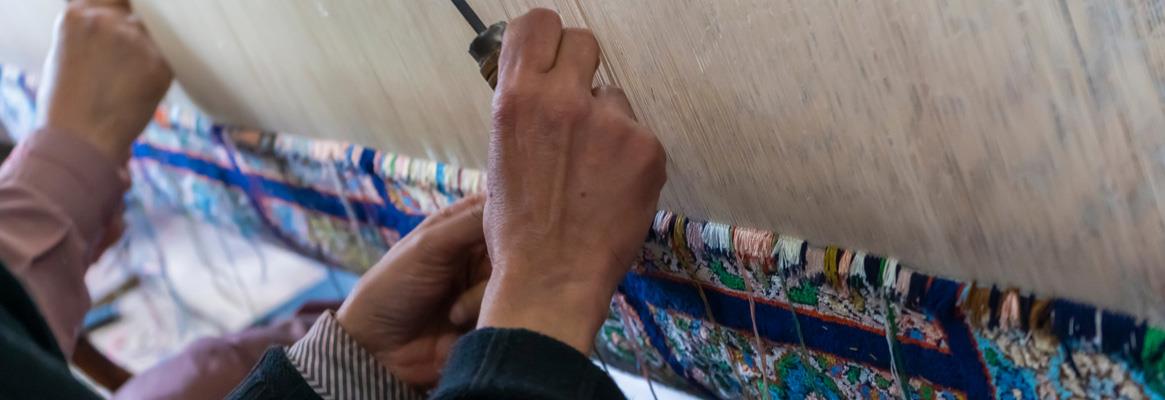The unique Namda rugs of Kashmir need government support, digital marketing and promotion initiatives for revival
Ever since Prime Minister Narendra Modi gave a speech on 'Vocal for Local' on May 12 this year, everyone has been thinking about handmade products. Textiles minister Smriti Irani was observed running a #vocalforhandmade campaign on Twitter on National Handloom Day. It is a decent initiative but the question is why do we need to be vocal for local? What is the need to buy products from local artisans?
Kashmir is world famous for its handicrafts. A few of these are pashmina weaving, sozni embroidery, kani shawl weaving, Kashmiri carpet, Kashmiri tilla work, papier machie, calico painting and basohli painting. The pashmina was once the most famous handicraft and was in huge demand abroad in the 18th century. Its old charm, however, has since faded. Another craft that is endangered and needs special attention now is 'namda', a rug made of wool by felting technique. The process of preparing a namda includes.
Carding: The process of removal of dirt and foreign particles from wool and achieving uniform and consistent thickness.
Creating the border: After carding, the border is created to define the outline under which filling will be done.
Creation of layer: The wool is then spread evenly with in that border and thick layers are created. For the third layer, the most un use dand unclean wool is used as it is the bottom most layer.
Sprinkling soap solution: A solution of soap and water is sprinkled over the layers with the help of a container and broom.
Rolling the namda: After sprinkling the soap solution, the mat is then tightly rolled and tied up with a rope and is then compressed by rolling to and fro on the floor with the help of hands and feet. This process is repeated for about an hour that allows the fusion of the fibres together-technically known as 'fibre to fibre' fusion.
Drying: After rolling the mat for an hour, the rope is untied and the mat is unrolled to discover the well-shaped namda. The derived plain namda is then dryed in the sun to remove any moisture present in the rug.
- Aari work: At the end, the namda. is embellished with beautiful ari work, which is optional.
1. Carding Solution

2. Creating the border

3. Creation of layer

4. Sprinkling soap solution

5. Rolling the Namda

6. Drying in sun

7. Aari work

Types of namda: There are numerous varieties of namda available; a few are pure woollen, while others are cotton mixed with wool namda. Some other variations are:
1. Plain namda: It is a type of plain rug with no embellishment.

2. Embroidered namda: These are embellished ones. Ari work is done on plain namda with different colours to make it look beautiful and attractive.

3. Cut work namda: In this, cut pieces are arranged as per the design while creating layers to get the desired result.

Namda is widely thought to have been originated in the 11th century during the reign of Mughal emperor Akbar. The history of the period reveals that Akbar ordered his exchequer to arrange for a suitable cover for his horse affected by biting cold. In response to that proclamation, a wise old man stood up and offered his felting services. Namdas of Kashmir are made from the wool of sheep found there and prepared by felting, instead of weaving, giving a unique texture.
Namda making has become a part-time activity now. It was listed as an 'Identifiable endangered craft of India' by the development commissioner, handicrafts. Work is needed on many fronts to revive this craft. The decline in the craft is reflected in the fall in its exports, which fell by almost 100 per cent within between 1998 and 2008.
There are a few reasons for its decline:
Raw materials: There is a continuous rise in the cost of raw materials and there is no fixed rate of these. Because of no or limited availability of wool carding machines, maintaining the standard of product has become tougher. Traditionally, handmade carding machines are now neither used nor being made because of its time consumption.
Human resource development: Due to low wages, most of the artisans have shifted to some other profession, and this has led to a shortage of skilled labour. There is a lack of training centres to improve skills of namda artisans, who are not aware of most government schemes.
Marketing: Artisans are still using the conventional method of selling. Due to a lack of knowledge of digital marketing, they are not able to compete with the world. They are not able to sell their products directly to customers because of involvement of middlemen.
Design upgradation: As there is a huge demand for product diversification, strong design intervention is needed.
A few challenges can be overcome with some attention. Arifa Jan from the state has done a lot as an activist for reviving this craft. Commitment to Kashmir, a charitable trust in the state, is also working on the same. Government and design institutes need to come forward to resuscitate this old craft.
About the author: Kumari Nayan Tara Singh is an assistant professor at the National Institute of Fashion Technology in Srinagar.
References:
1. https://www.businessoffashion.com/education/best-schools/undergraduate/fashion-design
2. https://www.jkhandicrafts.com/
3. http://www.handicrafts.nic.in/Page.aspx?MID=kFi9BTxkZgNrO1cpkwYIPQ==
4. http://www.handicrafts.nic.in/#
5. https://thekashmirwalla.com/2013/01/the-art-of-khatamband-and-panjrakari/
6. https://www.indiaheritagewalks.org/blog/namda-revival-dying-craft-kashmir
7. http://handicrafts.nic.in/pdf/List_Of_Identified_As_Endangered_Craft.pdf
8.https://gaatha.org/igaatha/details_process/Crafts/Dhurrie-weaving-craft/Namda-craft-detail-research
9. http://google.com











Comments